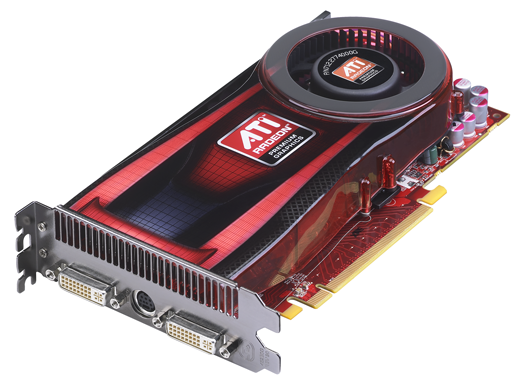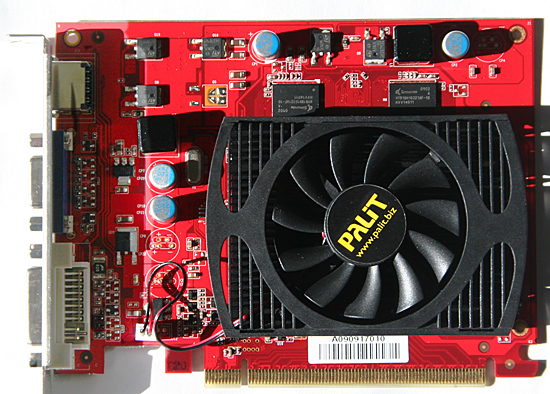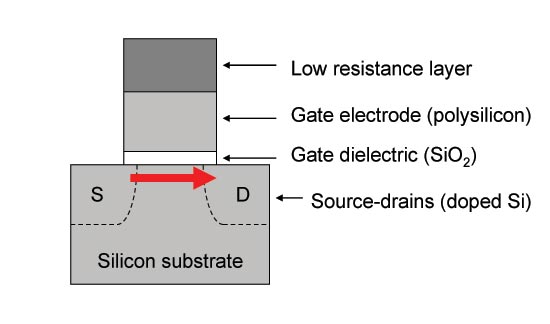The RV870 Story: AMD Showing up to the Fight
by Anand Lal Shimpi on February 14, 2010 12:00 AM EST- Posted in
- GPUs
The Payoff: How RV740 Saved Cypress
For its first 40nm GPU, ATI chose the biggest die that made sense in its roadmap. That was the RV740 (Radeon HD 4770):

The first to 40nm - The ATI Radeon HD 4770, April 2009
NVIDIA however picked a smaller die. While the RV740 was a 137mm2 GPU, NVIDIA’s first 40nm parts were the G210 and GT220 which measured 57mm2 and 100mm2. The G210 and GT220 were OEM-only for the first months of their life, and I’m guessing the G210 made up a good percentage of those orders. Note that it wasn’t until the release of the GeForce GT 240 that NVIDIA made a 40nm die equal in size to the RV740. The GT 240 came out in November 2009, while the Radeon HD 4770 (RV740) debuted in April 2009 - 7 months earlier.

NVIDIA's first 40nm GPUs shipped in July 2009
When it came time for both ATI and NVIDIA to move their high performance GPUs to 40nm, ATI had more experience and exposure to the big die problems with TSMC’s process.
David Wang, ATI’s VP of Graphics Engineering at the time, had concerns about TSMC’s 40nm process that he voiced to Carrell early on in the RV740 design process. David was worried that the metal handling in the fabrication process might lead to via quality issues. Vias are tiny connections between the different metal layers on a chip, and the thinking was that the via failure rate at 40nm was high enough to impact the yield of the process. Even if the vias wouldn’t fail completely, the quality of the via would degrade the signal going through the via.
The second cause for concern with TSMC’s 40nm process was about variation in transistor dimensions. There are thousands of dimensions in semiconductor design that you have to worry about. And as with any sort of manufacturing, there’s variance in many if not all of those dimensions from chip to chip. David was particularly worried about manufacturing variation in transistor channel length. He was worried that the tolerances ATI were given might not be met.

A standard CMOS transistor. Its dimensions are usually known to fairly tight tolerances.
TSMC led ATI to believe that the variation in channel length was going to be relatively small. Carrell and crew were nervous, but there’s nothing that could be done.
The problem with vias was easy (but costly) to get around. David Wang decided to double up on vias with the RV740. At any point in the design where there was a via that connected two metal layers, the RV740 called for two. It made the chip bigger, but it’s better than having chips that wouldn’t work. The issue of channel length variation however, had no immediate solution - it was a worry of theirs, but perhaps an irrational fear.
TSMC went off to fab the initial RV740s. When the chips came back, they were running hotter than ATI expected them to run. They were also leaking more current than ATI expected.
Engineering went to work, tearing the chips apart, looking at them one by one. It didn’t take long to figure out that transistor channel length varied much more than the initial tolerance specs. If you get a certain degree of channel length variance some parts will run slower than expected, while others would leak tons of current.
Engineering eventually figured a way to fix most of the leakage problem through some changes to the RV740 design. The performance was still a problem and the RV740 was mostly lost as a product because of the length of time it took to fix all of this stuff. But it served a much larger role within ATI. It was the pipe cleaner product that paved the way for Cypress and the rest of the Evergreen line.
As for how all of this applies to NVIDIA, it’s impossible to say for sure. But the rumors all seem to support that NVIDIA simply didn’t have the 40nm experience that ATI did. Last December NVIDIA spoke out against TSMC and called for nearly zero via defects.
The rumors surrounding Fermi also point at the same problems ATI encountered with the RV740. Low yields, the chips run hotter than expected, and the clock speeds are lower than their original targets. Granted we haven’t seen any GF100s ship yet, so we don’t know any of it for sure.
When I asked why it was so late with Fermi/GF100, NVIDIA pointed to parts of the architecture - not manufacturing. Of course, I was talking to an architect at the time. If Fermi/GF100 was indeed NVIDIA’s learning experience for TSMC’s 40nm I’d expect that its successor would go much smoother.
It’s not that TSMC doesn’t know how to run a foundry, but perhaps the company made a bigger jump than it should have with the move to 40nm:
| Process | 150nm | 130nm | 110nm | 90nm | 80nm | 65nm | 55nm | 40nm |
| Linear Scaling | - | 0.866 | 0.846 | 0.818 | 0.888 | 0.812 | 0.846 | 0.727 |
You’ll remember that during the Cypress discussion, Carrell was convinced that TSMC’s 40nm process wouldn’t be as cheap as it was being positioned as. Yet very few others, whether at ATI or NVIDIA, seemed to believe the same. I asked Carrell why that was, why he was able to know what many others didn’t.
Carrell chalked it up to experience and recounted a bunch of stuff that I can’t publish here. Needless to say, he was more skeptical of TSMC’s ability to deliver what it was promising at 40nm. And it never hurts to have a pragmatic skeptic on board.










132 Comments
View All Comments
tomoyo - Monday, February 15, 2010 - link
Another awesome article about the real situation behind the hardware from you Anand! I was on the USS Hornet and wish I had talked to you, but it was a great time nonetheless. It's interesting the change in their thought process between the RV770 and RV870, I hope they keep the winning streak up for the next refresh cycle (which hopefully will stay on the market bulges).WT - Monday, February 15, 2010 - link
*sigh* ^^^There's always one in the crowd.
Take care in the fact that you are the only person who hasn't enjoyed this read.
MegaManX4 - Monday, February 15, 2010 - link
Reminds me much of the Anglo-Saxon "documantaries", where it is always of tertiary relevance WHAT is actually discussed, but it is always of utmost interest how the responsible person "feels" about what he is just seeing, other than just stating the facts.There seems to be a huge crowd vowing for that kind of journalism, Whatever pleases the canaille.
"Jedem das Seine" or "to each his own" then
MegaManX4 - Monday, February 15, 2010 - link
This was actually the worst article i have ever read at anandtech. I know that you Americans always strive for emotionally .Driven stories, but this outright borders on silly exaggeration."Heroes of our Industry", what a Schmalz.
Also, if one would take the real informations presented in that article, it wouldn't justify even a 2 Page Article, let alone that 11 Page behemoth.
They are engineers, they do their jobs. Nothing more, nothing less.
Greetings from Germany
blowfish - Monday, February 15, 2010 - link
hmm, with an attitude like that you'll never get past middle management!Like most here, I loved this article. Anand obviously has the friendship and respect of some very senior players, and we were treated to some great insights into how things work at AMD ATI.
As the reader, you can choose to read or not read the article, simple as that. Maybe you should up your medication.
MegaManX4 - Monday, February 15, 2010 - link
unreasonable polemicpmonti80 - Monday, February 15, 2010 - link
You are the one being unreasonable. This may not be a "scientifically written" article, but no one is claiming it to be. And that's the reason this article is so interesting.saiga6360 - Thursday, February 18, 2010 - link
Apparently German engineers are just soulless robots. His confusion is understandable.BelardA - Monday, February 15, 2010 - link
I enjoyed this article even more than the RV770. I do recommend that everyone read that one too.Kind of shocking that Nvidia didn't use that info from the RV770 article to learn to NOT make big GPUs like the GTX 2xx. yeah yeah, it takes 2-4 years to design a chip.
I thank ATI (and AMD) for not playing marketing games like Nvidia does... I think they have a bigger marketing department than engineers nowadays. They started with the GF2-MX 400 & GF4-MX cards (which were re-labeled updated GF2 cards that were not up to GF3 standards)... but the latest cluster-muck of Nvidia products is nothing but a mess. 8800 re-badged as a 9800 re-badged into the gts 250. Code-name of NVxx go to G80 to G92 to G100. The GT-1xx products that are actually low-end 9xxx products, same with most G200 & G300. I'm not going to be surprised when the GTX 285 gets renamed into the GTS450 at $200! I've seen people who bought the GTS250 and post on the internet "why isn't my new gts250 much faster than my old 8800GT"... because you bought a faster version of your card and thought it was something new. Wow, 3 years with 3 names for the same product, that is marketing.
ATI does good with the entire 4000 series being DX 10.1 products and 5000s are DX11. (Does anyone really use HD-5xxx?) It doesn't feel like ATI is pulling our chain with their products.
AMD should be learning from ATI, they are getting better with CPUs - 2 years late, but AMD CPUs are now faster than Core2 and compete well against the lower end intel i-confused model CPUs. There is still room for improvement which was recommend to them some time ago, but AMD is just going to come out with a new design for next year. But had AMD tweaked their CPUs a bit for another 10~20% performance, they'd be up there with i7s.
I hope in the next ATI GPU, some form of Physics engine is added to go up against nvidia's PhsyX. But perhaps that'll be part of DX12... but Microsoft no longer supports Games for Windows.
Actually, with more and more games going ONLY to consoles, I don't think the need for high-end gaming cards will be needed anymore in the next few years. If there are no games, who needs a $300 3D Gaming card?
Zink - Monday, February 15, 2010 - link
Would also like to say great article. I can't wait for new distributed computing cores come out optimized for ATI's architectures.